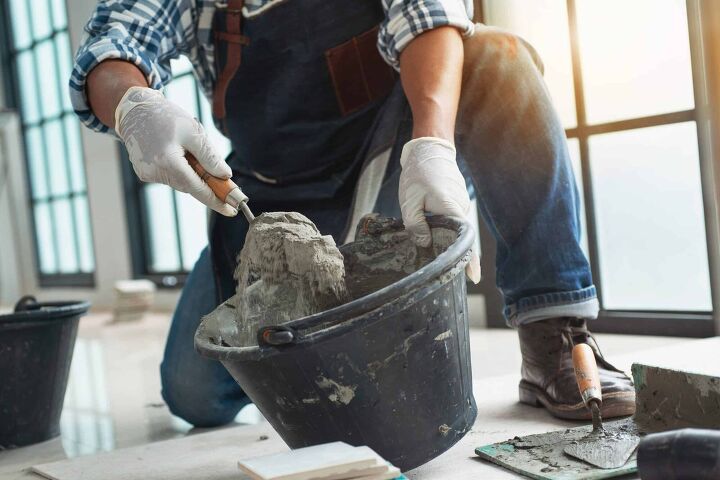How To Dissolve Concrete In A Drainpipe (Step-by-Step Guide)

It happens to the best of us; we’re so involved in getting our new project done that we become careless and overlook something. Maybe you cleaned your tools wet with concrete near the drain system or some of the powdered concrete mix ended up spilling into a sink. Whatever the reason, now you have to figure out how to dissolve concrete in the drainpipe.
To dissolve concrete in a drainpipe, use a concrete dissolver, acid, a plumbing snake, or an electric power auger. If the concrete is still wet, use a shop vac to remove the concrete (make sure to clean your vac thoroughly). Pour dissolver if necessary, wait, then use the shop vac to suck out the concrete. You can also use a high-pressure hose to flush the line.
The purpose of this article is not to advertise for any specific drain cleaning product. When mentioning a certain brand, it is because that is what an expert or professional has recommended. A professional-grade concrete dissolver may be your only hope of getting that drain cleared.
Do You Need Drain Cleaning Services?
Get free, zero-commitment quotes from pro contractors near you.

Sakrete Concrete Dissolver
Sakrete is a safe and environmentally friendly concrete dissolver that works just as good as acid. But it is not hazardous to breathe or touch, is 100% biodegradable, and is much faster than most dissolvers.
Just pour it in the drain and allow it to sit for 15 to 30 minutes. Then pour some more and let it sit for another 15 to 30 minutes. Rinse it out with a high-pressure washer or a hose with a pressure nozzle on it.
Mean Klean
For an eco-safe formula that dissolves concrete, Mean Klean is one of the most popular. According to the experts, if you pour this in the drain where the concrete is and let it sit, it will eventually turn the concrete into mush. It also removes grout, stucco, and mortar.
There are no dangerous acids or fumes to worry about with Mean Klean because it is non-toxic and biodegradable. In fact, it is also non-corrosive, so it does not harm the pipes or equipment being used.
Croc Crete
This is a biodegradable mixture that works well in getting concrete out of your pipes. It will also get rid of leveling compound, grout, and mortar. You will need to pour it in the pipe, let it sit for some time, and then use a hydro jet or pressure washer to blow it out of there.
In some cases, it can take 48 hours. This is typically for concrete that has been in the pipe for more than a week. However, with grout or newly formed concrete, 24 hours is usually sufficient. You may have to do this several times to get it all out depending on how much is in there and how long it has been there.
How to Use Concrete Dissolver
With any of these concrete dissolving products, you have to use it on dry concrete. So, if you have been running water in the drain and have a water backup, you will have to get rid of it. The easiest way to do this is by using a shop vac. Here are the best steps in this process.
- Use the shop vac to suck out any water or other loose debris from the drain.
- Wait 24 hours for the concrete to dry completely.
- Pour one cup of the concrete dissolving product in the drainpipe.
- Wait 24 hours and pour another cup of the product in. Do not get any water in the drain.
- After another 12 to 24 hours, use the shop vac to suck out the sludgy concrete. If there is still concrete in there, pour another cup and wait another 24 hours.
- Get rid of any remaining sludge with the shop vac.
- Use an auger or plumbing snake to get rid of any remaining concrete.
- If any concrete remains, keep using one cup of the product at a time and letting it sit for 24 hours until it is mostly gone.
- Use a pressure washer to clean any remaining residue out of the drain.
Using Acid on the Problem
If you have never used acid (hydrochloric acid) before, we suggest you do some research first. It is a dangerous chemical to use and you have to protect your skin, eyes, and lungs when working with it. You should be wearing long rubber gloves, a mask, and eye protection while using acid of any kind.
Carefully pour one cup of acid into the drain slowly. Let it sit for three to four hours. Then flush the drain with at least four gallons of water. Afterward, you can use a plunger or plumbing snake to get rid of the rest of the concrete. Make sure all of the acid is removed before doing this though.
Use a Plumbing Snake
Also known as an auger, a plumbing snake is a long cable made of steel that can clear up clogs. Push the cable in the drain as far as it will go and turn the handle to twist the end of the cable. Continue to do this until the drain is clear or until you give up and want to try the next idea.
Try an Electric Power Auger
You can rent a professional power auger to get rid of tough clogs like concrete as well. You will need to learn a bit about how to use it right before attacking the problem, though so you do not do any damage to your pipes. Just check out some YouTube videos online and you will be a pro in no time.
Flush The Line
Use a large volume of water through a high-pressure hose to flush the line. You will need to run the water through the line for quite some time to ensure all the concrete flushes out of the line and doesn’t just get stuck further down it.
The Last Resort: Replacing the Drainpipe
If you have exhausted all of your ideas and your drainpipe is still clogged up, you may as well just give up and call a plumber. They will have to tear up the flooring and remove the pipe. If you do not know a plumber off-hand, do your homework before choosing one. Get referrals, check reviews, and talk to other customers first so you know you have the best plumber for the job.
Related Questions
How Does Concrete Get into Drainpipes?
Believe it or not, it happens more often than most people think. Especially if you work in the construction field. If you work with concrete, grout, and other hardening materials all day and do not clean it all off before showering every day, where do you think that stuff is going? And if you are doing a DIY project at home, washing your tools in the sink can cause this issue as wellAnother common cause of concrete getting into drainpipes is when you wash your clothes. After a day of working with concrete, you cannot just throw away your clothes every day. So, you wash your work clothes in the washing machine. Any of these materials that come off go right down the drain where they will eventually cause a clog.
Do You Need Drain Cleaning Services?
Get free, zero-commitment quotes from pro contractors near you.

Many think that concrete and cement are the same things. But they are not the same. Cement is made of silica, clay, limestone, and calcium. It works great to bind small areas, but it is prone to cracking.
There is cement in the concrete, though. When you use cement mix with water, it turns into concrete. But cement is only about 15% of the concrete mix. When you mix the water into the cement, these things harden and turn into a solid mass like a rock. It continues to get stronger as it gets older.

I am a DIYer who loves writing about anything home-related. When I am not writing, you can find me studying for my PhD in Psychology, photographing nature, and swimming at the lake with my grandkids.
More by Patricia Oelze























![12 Washing Machine Brands to Avoid [with Recall Data]](https://cdn-fastly.upgradedhome.com/media/2023/07/31/9075781/12-washing-machine-brands-to-avoid-with-recall-data.jpg?size=350x220)



